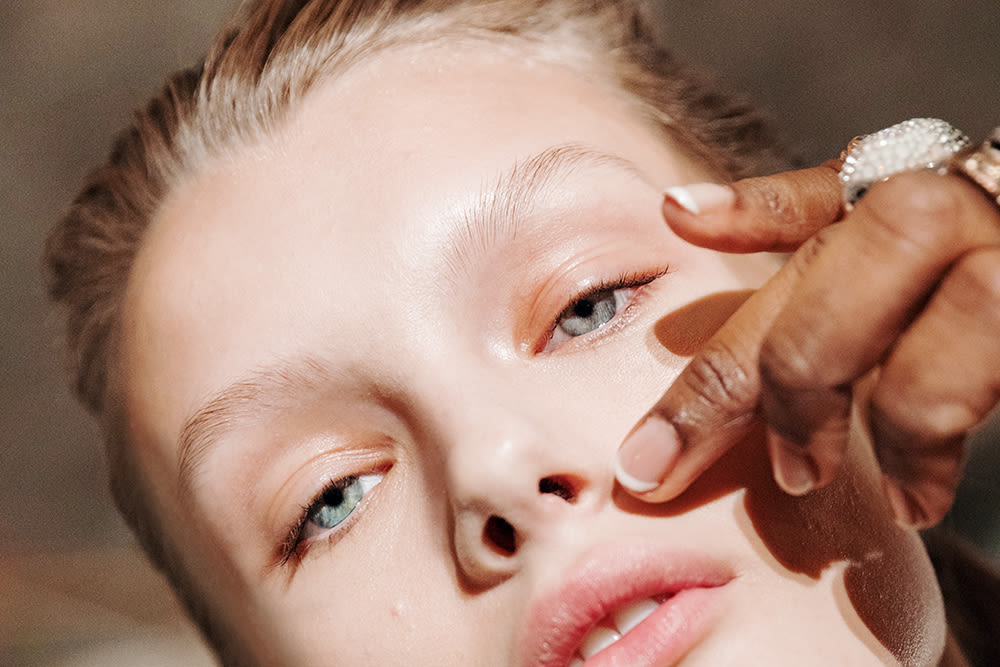Hello and welcome to another hot and fresh take on ITG’s personal nemesis: the pimple. Like any nemesis, the pimple gets talked about a lot 'round these parts—how to get it to leave, how to get it to stop being so dramatic and red, how to stop it from scarring you, both physically and emotionally. But now there’s something else to consider—how do you conceal a pimple? You don’t have to, of course, but isn’t it nice to to know how, in case you want to? Knowledge is power, folks, and six of ITG’s favorite makeup artists chipped in for a pimple-covering masterclass. So get your pencils ready and pay attention. The enemy is within and you’re going need to learn a few tricks to stop it from stealing the show that is your skin.
The makeup artists
Marie-Josée Leduc
Amy Strozzi
Shayna Goldberg
Grace Ahn
Pati Dubroff
Benjamin Puckey
Lesson #1—Skincare first
Marie-Josée Leduc: "Extra TLC is needed when working with acne-prone skin. A witch hazel-based toner is a super important step because toner has antiseptic qualities to take away bacteria that exacerbates breakouts. After toner, I massage in a few drops of Rose Serum to give the skin an extra protective layer. This is all accomplished in a few minutes."
Grace Ahn: "I wet a Q-tip with Glossier Solution and make small, circular motions to gently exfoliate any flakes or dead skin off the blemish."
Lesson #2—It’s all about the base
Shayna Goldberg: "First I'll go in with a light primer to help balance the texture."
Amy Strozzi: "I like to do foundation before concealer—it provides some coverage and a good base to hold the concealer in place without it sticking to certain areas. When a spot is inflamed and red, I like to color correct the area with either a touch of green or yellow, whichever works best for the skin tone. A tiny amount using a precise brush will cut the tone—let it set for a moment before you layer your concealer over it."
Pati Dubroff: "A fuller coverage foundation applied very sparingly with a brush should lay down a bit of initial coverage."
Benjamin Puckey: "Personally, I find that I get a more natural look when I use concealers without foundation underneath. Instead, I layer it over a gel moisturizer like Clinique's Dramatically Different Moisturizing Jelly."
Lesson #3—Choose the right formula…
Benjamin: "The skin on an acne lesion is usually shiny and raised, which is why it doesn’t hold on to product very well. Anything with an oil base will just slide off—instead, look for a concealer with a silicone base. Silicone oil evaporates, leaving your concealer firmly in place."
Pati: "If the blemish has a lot of dryness around it, I like to use the Glossier concealer because it has some moisture and still gives great coverage. But for very stubborn spots, I use a dry, full coverage concealer like Clé de Peau’s."
Shayna: "Clé De Peau's concealer is matte and opaque, and it really behaves in terms of coverage."
Amy: "I like to use Laura Mercier Secret Camouflage because each palette has a neutral shade and a correction shade."
Pati: "A palette that includes two tones of concealer like Secret Camouflage can be really helpful when someone has uneven skin tone, because you can mix to them to match."
Grace: "I use Nars Radiant Creamy Concealer for most blemishes, but for intense blemishes I use Kevyn Aucoin Sensual Skin Enhancer."
Benjamin: "A trusted favorite of mine is the Estée Lauder Double Wear Maximum Cover Foundation used as a concealer, though I also love the Kat Von D Lock It Concealer—they both grip onto skin and stay put."
Pati: "Always make sure that the concealer is the same shade as the cheek."
Lesson #4—Get the right tools
Benjamin: "Use the back of your hand as a palette to keep acne bacteria from getting into your concealer."
Grace: "It’s important to never use a rubbing motion—you want the concealer to be concentrated just on the blemish. A brush like Sigma F68 is good for precision."
Amy: "Having a narrow, pointed brush is key for getting exact coverage on the actual spot."
Benjamin: "You can also find the best brushes at the art supply store."
Shayna: "I like using my fingers to press the concealer into place."
Amy: "Then use a clean, small smudge brush to feather out the edges of the concealer on to the skin so it blends."
Lesson #5—Finish it off
Shayna: "I'll sometimes use a fluffy eyeshadow brush for a light dusting of powder, like Charlotte Tilbury's Air Brush Flawless Finish, on the spot."
Amy: "A translucent powder with no sheen will set the concealer. Both Laura Mercier and Dior make fantastic translucent powders—a good one is finely milled and disappears on the skin. But if the spot is very inflamed and still shows red, I use a yellow-toned powder from Bobbi Brown."
Marie-Josée: "When it comes to applying makeup after, like blush, I’m very careful to use an extra soft brush so I won’t remove any foundation."
Benjamin: "It’s precision work."
Pati: "Going spot by spot is time consuming, but really makes a difference."
Shayna: "My goal is always to only use as much as necessary, so skin stays looking like skin."
—as told to ITG
Photo via ITG

